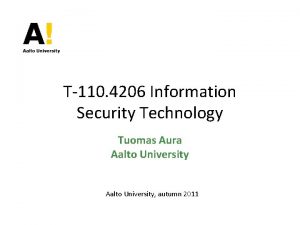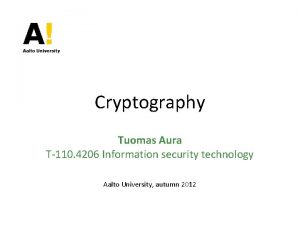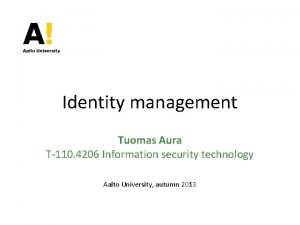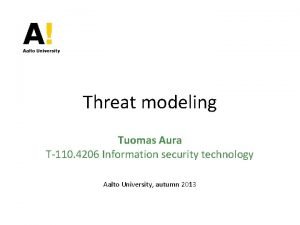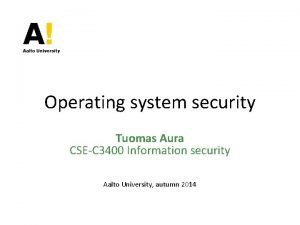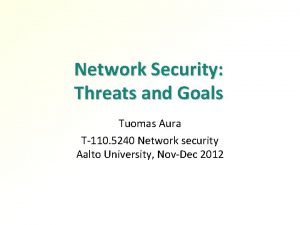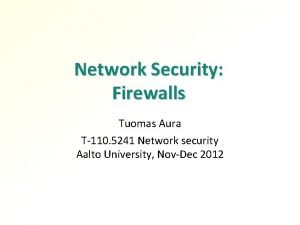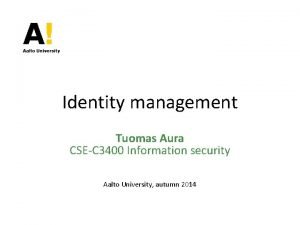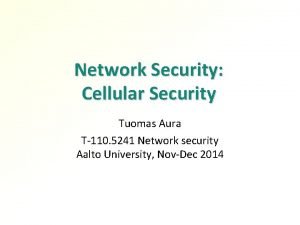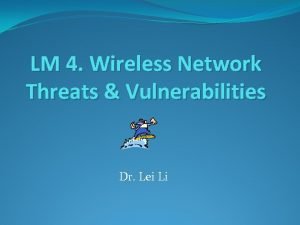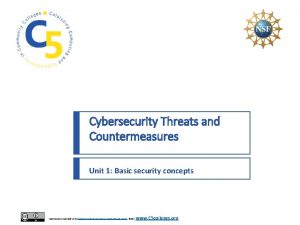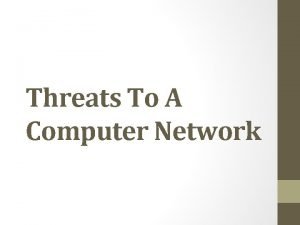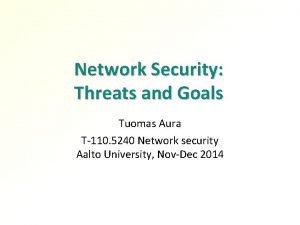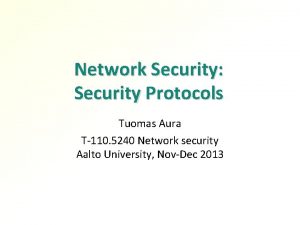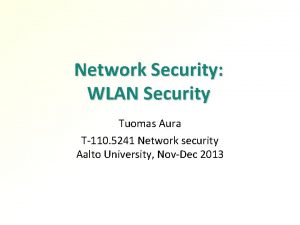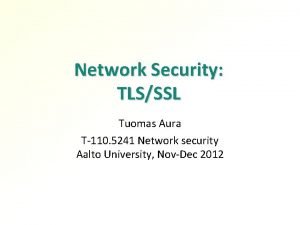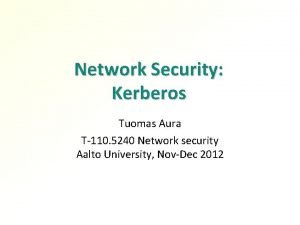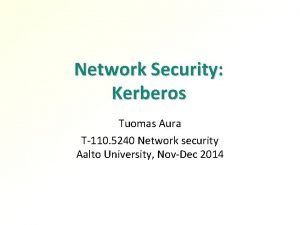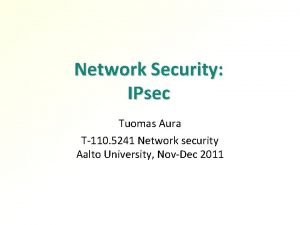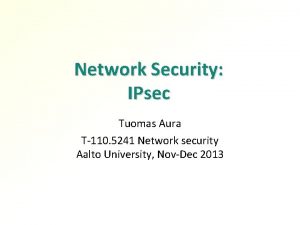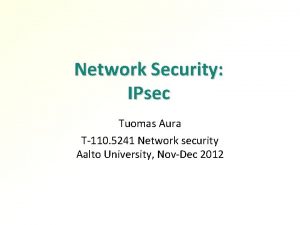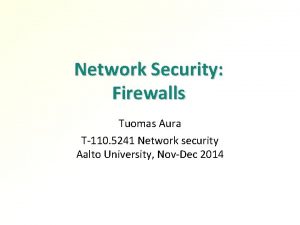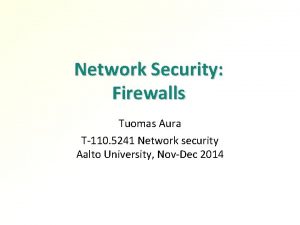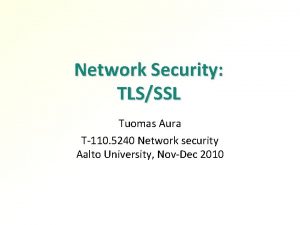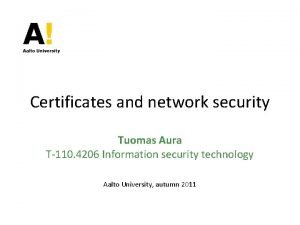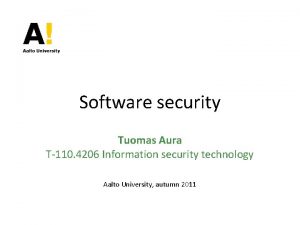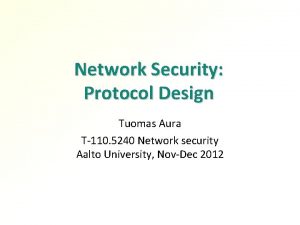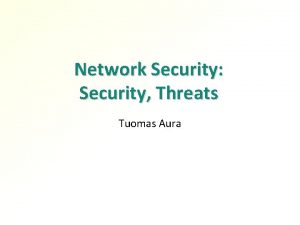Network Security Threats and goals Tuomas Aura T110


























- Slides: 26

Network Security: Threats and goals Tuomas Aura T-110. 5240 Network security Aalto University, Nov-Dec 2011

Outline 1. 2. 3. 4. 5. Network security Basic network threats: sniffing and spoofing Role of cryptography Security and the network protocol stack First security protocols: replay and freshness 2

Network security 3

What is network security Network security protects against intentional bad things done to communication Protect messages (data on wire) and communication infrastructure Network security goals: Confidentiality — no sniffing Authentication and integrity — no spoofing of data or signaling, no man-in-the-middle attacks Access control — no unauthorized use of network resources Availability — no denial of service by preventing communication Privacy — no traffic analysis or location tracking

Who is the attacker? We partition the world into good and bad entities Honest parties vs. attackers Good ones follow specification, bad ones do not Different partitions lead to different perspectives on the security of the same system Typical attackers: Curious or dishonest individuals — for personal gain Hackers, crackers, script kiddies — for challenge and reputation Political activists — for political pressure Companies — for business intelligence and marketing Security agencies — NSA, FAPSI, GCHQ, DGSE, etc. Military SIGINT — strategic and tactical intelligence, cyber-war Organized criminals — for money Often, not all types of attackers matter E. g. would you care if NSA/university/mom read your email? 6

Basic network threats: sniffing and spoofing 7

Traditional network-security threat model Me ss ag es Network = Attacker s Me ge a s s End are nodes trusted, the network is unreliable End nodes send messages to the network and receive messages from it Network will deliver some messages but it can read, delete, modify and replay them Metaphors: unreliable postman, notice board, rubbish basket 8

Basic network security threats Traditional major threats: Sniffing = attacker listens to network traffic Spoofing = attacker sends unauthentic messages Data modification (man in the middle) = attacker intercepts and modifies data Corresponding security requirements: Data confidentiality Data-origin authentication and data integrity 10

Man in the middle (Mit. M) In the man-in-the-middle attack, the attacker is between the honest endpoints Attacker can intercept and modify data → combines sniffing and spoofing On the Internet, a Mit. M attacker must be at the local network of one of the end points be at a link or router on the route between them, or change routing to redirect the packets via its own location Note: Just forwarding data between two endpoints (like a piece of wire) is not an attack. What does the attacker gain? 18

Other network threats What other threats and security requirements are there on open networks? Other threats: Unauthorized resource use (vs. access control) Integrity of signalling and communications metadata Denial of service (Do. S) (vs. availability) Traffic analysis, location tracking Lack of privacy Software security Not captured well by the traditional networksecurity model 19

Role of cryptography 20

Cryptographic primitives Symmetric (shared-key) encryption for data confidentiality Block and stream ciphers, e. g. AES-CBC, RC 4 Cryptographic hash function E. g. SHA-1, SHA 256 Message authentication code (MAC) for data authentication and integrity E. g. HMAC-SHA-1 Public-key (or asymmetric) encryption E. g. RSA Public-key signatures E. g. RSA, DSA Diffie-Hellman key exchange Random number generation

Crypto Wars – some history Until ‘ 70 s, encryption was military technology In ‘ 70 s and ‘ 80 s, limited commercial applications American export restrictions and active discouragement prevented wide commercial and private use Reasons to ban strong encryption: Intelligence agencies (e. g. NSA) cannot spy on encrypted international communications Criminals, terrorists and immoral people use encryption In ‘ 90 s: PGP, SSL, SSH and other commercial and opensource cryptography became widely available Activists argued that cryptography was a tool for freedom Researchers argued that weak crypto is like no crypto Most export restrictions were lifted in 2000 22

Security and the network protocol stack 25

Protocol Stack and Security Application E. g. email: PGP, S/MIME Middleware E. g. XML Encryption TCP, UDP, . . . (transport) IP (network) Ethernet protocol Physical network TLS/SSL, SSH IPSec 802. 1 X, WEP Security solutions exist for every protocol layer Layers have different security and performance tradeoffs, trust relations and endpoint identifiers 26

End-to-end security Security should be implemented between the endpoints of communication. All intermediaries are part of the untrusted network End-to-end security only depends on the end nodes Hop-by-hop (link-layer) security assumes all routers are trusted and secure End-to-end security protocols are independent of the network technology at intermediate links Link-layer security is different for each link type Confidentiality and authentication are usually user or application requirements Network or link layer only cannot know application-level requirements But link and network layer infrastructure and signalling need protection, too 28

Endpoint names Authentication and integrity depend on names (identifiers) Each protocol layer has its own way of naming endpoints: Ethernet (MAC) addresses in the link layer (e. g. 00 -B 0 -D 0 -05 -04 -7 E) IP address in the network layer (e. g. 157. 58. 56. 101) TCP port number + IP address DNS or Net. BIOS name in the higher layers (e. g. vipunen. tkk. fi) URI in web pages and services (e. g. http: //www. example. org/myservice) 29

First security protocols: replay and freshness 31

The first broken protocol Meet Alice and Bob! A → B: M, SA(M) E. g. , SA(“Attack now!”) What is wrong with this protocol? 32

Replay and freshness Replay problem: A → B: M, SA(M) // SA(“Attack now!”) Authentication is usually not enough in network security! Need to also check freshness of the message “Fresh” may mean that the message was sent recently, or that has not been received before (exact definition depends on application) Freshness mechanisms: Timestamp Nonce Sequence number 33

Timestamps Checking freshness with A’s timestamp: A → B: TA, M, SA(TA, M) E. g. SA(“ 2010 -11 -03 14: 15 GMT”, “Attack now!”) Timestamp implementations: Sender’s clock value and time zone (validity ends after fixed period) Validity period start and end times (or start and length) Validity period end time Q: What potential problems remain? Timestamps require clocks at the signer and receiver, and secure clock synchronization Secure fine-grained synchronization is hard to achieve; loose synchronization (accuracy from minutes to days) is easier Also, fast replays possible: SA(TA, “Transfer £ 10. ”) 34

Nonces What if there are no synchronized clocks? Checking freshness with B’s nonce: A → B: “Hello, I’d like to send you a message. ” B → A: NB A → B: NB, M, SA(NB, M) Alice’s nonce is a bit string selected by Alice, which is never reused and (usually) must be unpredictable Nonce implementations: 128 -bit random number (unlikely to repeat and hard to guess) timestamp concatenated with a random number (protects against errors in RNG initialization and/or clock hash of a timestamp and random number Problematic nonces: sequence number, deterministic PRNG output, timestamp Nonces require extra messages and are not well suited for asynchronous or broadcast communication 35

Sequence numbers What if there are no synchronized clocks and nonces do not fit into the protocol design? Sequence numbers in authenticated messages allow the recipient to detect message deletion, reordering and replay A → B: seq, M, SA(seq, M) E. g. SA(44581, “Transfer 30€ to account 1006443. ”) Dangerous, but can sometimes ensure that messages are not processes out of order or twice Good combination: timestamp from a loosely synchronized clock and sequence number 36

Puzzle of the day What should be the order of signing, compression and encryption? 39

Related reading William Stallings, Network security essentials: applications and standards, 3 rd ed. : chapter 1 William Stallings, Cryptography and Network Security, 4 th ed. : chapter 1 Dieter Gollmann, Computer Security, 2 nd ed. : chapter 13 Ross Anderson, Security Engineering, 2 nd ed. : chapter 6 40

Exercises Design a more spoofing-resistant acknowledgement scheme to replace TCP sequence numbers. Hint: use random numbers (and maybe hashes) to ensure that acknowledgements can only be sent by someone who has really seen the packets Which applications of hash functions in network protocols require strong collision resistance? Which do not? Why is link-layer security needed e. g. in WLAN or cellular networks, or is it? To what extent are the identifiers in each protocol layer of the TCP/IP unique? Does one layer in the protocol stack know the identifiers of other layers? How do the properties of these identifiers differ: IP address, DNS name, email address, person’s name, national identity number (HETU) 41
 Tuomas aura
Tuomas aura Tuomas aura
Tuomas aura Tuomas aura
Tuomas aura Tuomas aura
Tuomas aura Tuomas aura
Tuomas aura Tuomas aura
Tuomas aura Tuomas aura
Tuomas aura Tupas finland
Tupas finland Trust key t110
Trust key t110 Tuomas aura
Tuomas aura Seizure vs syncope
Seizure vs syncope Modern network security
Modern network security Strategic goals tactical goals operational goals
Strategic goals tactical goals operational goals Strategic goals tactical goals operational goals
Strategic goals tactical goals operational goals Wireless security threats and vulnerabilities
Wireless security threats and vulnerabilities Cyber security threats and countermeasures
Cyber security threats and countermeasures Wireless security in cryptography
Wireless security in cryptography Ecommerce security threats
Ecommerce security threats Wireless security threats
Wireless security threats Common computer security threats
Common computer security threats Private secruity
Private secruity Explain osi security architecture
Explain osi security architecture Guide to network security
Guide to network security Electronic mail security in network security
Electronic mail security in network security Security guide to network security fundamentals
Security guide to network security fundamentals Security guide to network security fundamentals
Security guide to network security fundamentals General goals and specific goals
General goals and specific goals
